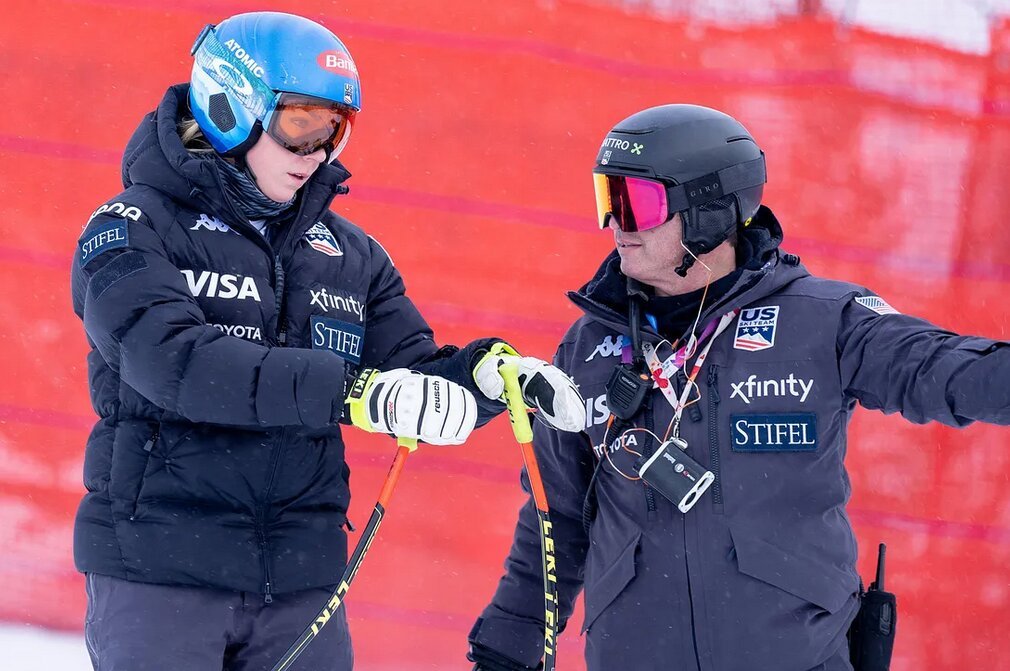Race Line
Image by Ron LeMaster
Overview
Where to ski through a racecourse—the Race Line—is just as important as how to ski through a racecourse.
Discover where you should begin your turn relative to the Rise Line.
There are three primary Race Lines — Wide, Direct, and Recovery.
The Rise Line
The Rise Line is an imaginary line that extends straight uphill from a gate (see picture below) and is a key reference point for starting your turn.
The decision of when to start your turn in relation to the Rise Line depends on the type of course, turn shape, terrain, and your speed.
Image by Sipa USA/Alamy/Graphics by ARM
Watch about a MINUTE of this VIDEO describing how the racer starts their turn at the Rise Line.
Video by Gilmore Gardens NH
Three Lines
The three main lines are the Wide Line also called the High Line, the Direct Line, and the Recovery Line. These lines apply to Slalom, Giant Slalom and Speed events.
Image by ARM
Wide Line
For standard Giant Slalom and Slalom gates, start the turn just before reaching the Rise Line. This will allow you to execute a rounder turn shape, maintain speed and control while avoiding a late, skidded turn that costs time.
Starting your turn early places the apex—where your skis make the sharpest change in direction—just above the gate.
When arcing a turn, it's crucial to position your outside ski at an appropriate distance from the gate to allow the ski to be on edge, bend and carve. These distances can vary based on factors such as skier technique, course setting, and snow conditions.
The Wide Line is demonstrated in the following pictures of Giant Slalom and Slalom turns.
Image by Ron LeMaster/Graphics by ARM
Image by Ron Le Master / Graphics by ARM
An explanation of why the Wide Line is faster and safer is presented by this video.
Video by Lee Morse
Direct Line
The Direct or Aggressive Line can often be faster when the racecourse straightens out.
Begin your turn earlier in relation to the Rise Line to ski a more direct path toward and around the gate.
Concentrate on executing a clean, carved turn. If your skis begin to skid or slide sideways, it means your line is too direct.
Image by Live Media Publishing Group/Alamy/Graphics by ARM
Video of Wide and Direct Lines
Watch Mikaela Shiffrin win a slalom race by skiing the Wide line, followed by the more aggressive Direct line when the racecourse straightens out.
Video by FIS Alpine
Recovery Line
The Recovery Line is when the racer finds themselves in a sub optimal location on the racecourse, making it challenging to smoothly carve towards the next gate.
You can perform a Recovery Action which may include a pivot turn or double pole plant, or for safety reasons ski out of the course.
The racer is working hard to recover from taking a late line on the racecourse in this picture.
Screenshot from Video by Alpine Ski Racing Coach’s Corner
Stivot Turns
Stivot turns are effective on steep, icy and rough terrain where traditional carving turns might not be possible.
Inspection
Learn how inspecting and visualizing the racecourse will help you ski your optimum line.
Look Ahead
Learn how ‘Looking Ahead’ will help you ski your preferred line through a racecourse.
Key Takeaways
In ski racing, selecting the appropriate racing line through the course is crucial. There are three primary lines to consider: the Wide Line, the Direct Line, and the Recovery Line.
The Wide Line, also known as the High Line, is generally the safest and faster choice for carving turns. It involves starting the turn just before reaching the Rise Line, allowing racers to arc a clean carved turn towards the next gate.
The Direct Line can be faster on straighter sections of the course by starting the turn before the Rise Line.
The Recovery Line is used when racers find themselves in sub optimal positions on the course, requiring a Recovery Action such as Pivot turn.
’Stivot’ turns are sometimes appropriate when the racecourse becomes steep, icy, and rough.
Suggested Learning Modules
Return to Slalom
Important Message: Skiing and ski racing involve inherent risks. It’s essential to ski responsibly and stay within your skill level and personal comfort limits.










